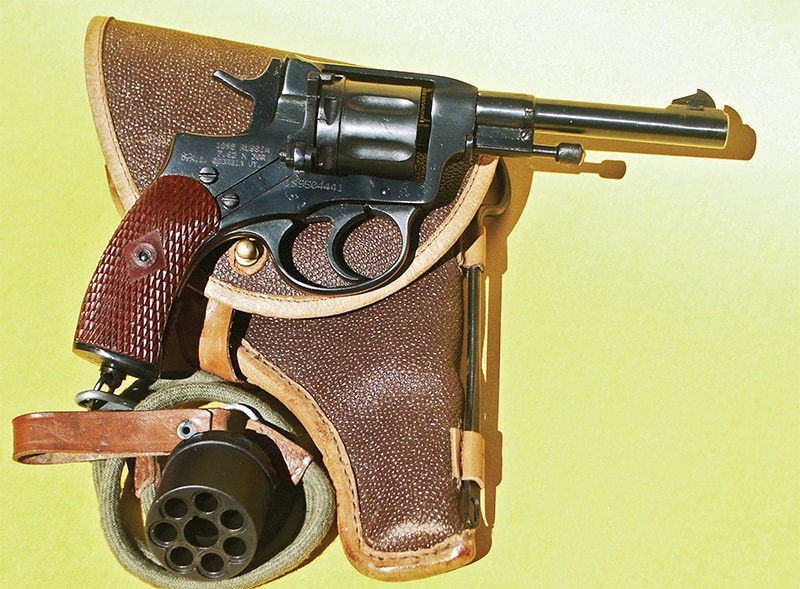Russia's Gas-Sealing Nagant
How a revolver of this complexity stayed on serious active duty for 50 years is still astonishing!
The name, Nagant, is prominent in Russian small arms history. It’s a name that is associated with Russia’s famous service rifle and carbines, the Mosin-Nagants. When it comes to handguns, the name, “Nagant,” in Russia carries with it the same weight and immediate recognition as “Colt” does in the United States.
Strangely enough, Nagant, or I should say, the “Nagants,” were not Russian. Emile and Henri-Leon Nagant were brothers, gifted gunmakers, and Belgians. In 1859, the brothers established the firm of “Fabrique d’Armes Emile et Leon Nagant” in that hotbed of fine Belgium gunmaking, Liege.
Their rise to prominence was propelled in 1867 when Remington licensed the Nagant firm to produce Remington rolling block firearms for the European trade. The firm’s production capacity was apparently considerable. The Nagants made tens of thousands of rolling block rifles, shotguns and pistols for the military and sporting trades, even designing a unique double barrel shotgun of their own based on the rolling block system.
Used Around The World
The Nagants’ first commercially successful revolver appeared in 1878 and was purchased by the Belgian military. Following that came a series of improved models designated by their year of issue — 1883, 1884, 1886, 1887, 1893 — adopted by militaries of countries like Belgium, Sweden, Norway, Denmark, Luxembourg, Serbia, Brazil and Argentina.
Next to the Russian Nagant, the Swedish Nagant in 7.5mm, made by Husqvarna and imported into the U.S. in the ’50s and ’60s, is probably the most commonly seen model in collecting circles.
What’s interesting about all of the preceding models is their rather conventional design. Outwardly, they look very much like an 1895 Russian Nagant, but they were chambered for a standard looking handgun cartridge, and they were not designed to be gas-sealing. That was to come later.
Needing to modernize their small arms, Russia began testing rifle designs supplied by the Nagants and their own Colonel Ivanovich Mosin in 1890. The result was that the best features of the Nagant and the Mosin designs were blended into a final model. The rest is history. The Mosin-Nagant rifle/carbine soldiered on from 1891 well into the 1950s. The Nagant long arms are a story unto themselves that will soon be covered in a future “Surplus Locker.”
Having adopted a new rifle, Imperial Russia began casting about for a replacement for their famous S&W Model 3 Russian revolvers in .44 Russian. They wanted a smaller size, lightweight revolver firing a smokeless powder cartridge that shared the same 7.62mm bore with their Mosin-Nagant rifles.
More Efficient Revolvers
Being the good businessmen they were and already being firmly established with the Russian military, the Nagants lost no time in making available their standard military revolver models plus an entirely new gas-sealing model for testing.
Interestingly, the Nagant brothers did not invent the gas-sealing revolver or its unique cartridge with its bullet seated inside the case. But they knew a good design when they saw it. The credit goes to another prolific Belgian gunmaker, Henri Pieper. Nagants’ gas-sealing cartridge looks exactly like Pieper’s, featuring a case that encloses the bullet and projects beyond the cylinder face to seal the barrel upon discharge. Pieper’s revolver design, featuring a swingout cylinder was apparently rather complex and considered too fragile for rough field use. It ended up in the dustbin of history, but Pieper’s cartridge concept lived on.
And so the Nagants went on to cement their second firearm design solidly in Imperial Russia — the Nagant Model 1895 gas-sealing revolver. It was a longlived design. More than 2,000,000 Russian Nagants were produced between 1895 and 1944. Initially produced in Belgium, production was shifted to the Tula arsenal in 1899.
Curiously enough, the 1895 model was also produced in Poland at the Radom arsenal, beginning in 1930, when the Poles bought the 1895 production machinery from Nagant during a liquidation sale.
To understand the unique mechanism of the Russian Nagant, you have to think of it in terms of a system. The system consists of the distinctive 7.62mm Nagant cartridge and the revolver itself. The purpose of the system is to eliminate the cylinder gap found in conventional revolvers, thereby preventing any loss of gas and maximizing the ballistics of Nagant round. And it works.
Remarkable Design
The double action Nagant is a solid frame revolver with a seven shot cylinder that does not swing out to load or eject cases. It’s loaded through a loading gate and the empty cases are ejected by an ejector rod. In that regard, the Nagant is somewhat of a blend between a classic double action and a classic single action revolver.
The cylinder incorporates a central spring loaded bushing that permits the cylinder to move forward and backward. The bushing is secured in place by a solid arbor that passes through the front of the frame, through the middle of the bushing and is locked in place by the pivoting barrel and ejector rod.
The cylinder is rotated by a conventional looking hand and ratchet system. As the trigger is pressed and the hammer is approximately half way back, the cylinder has turned one seventh of a revolution. At that moment, the cylinder bolt snaps into place at 6 o’clock and the edge of the loading gate catch engages a notch in the cylinder edge at 1 o’clock.
The cylinder is now solidly locked against any further rotation and can only move forward. The hand keeps pressing against the ratchet as the hammer continues rearward. The cylinder now moves forward positioning the mouth of the Nagant cartridge inside the throat of the barrel and sealing off the breech end of the barrel.
With the cartridge moving forward, what maintains the base of the case in contact with the breech face? Here’s where the Nagants were ingenious.
They designed a breech block that is moved forward against the base of the case by a vertically sliding breech bolt that is moved into battery by the trigger arm.
That’s why the Nagant has such a long, odd looking firing pin. The firing pin has to extend through the frame and then through the extended breech block to impact the primer.
After the shot has been fired and the trigger released, the breech block is retracted, the cylinder is moved back into position by the compressed bushing spring, and the cycle is ready to begin again.
Heavy Trigger, Slow Ejection
As you might surmise, the double action pull of a Nagant is heavy. You’re doing a lot of work when you pull that trigger. You are rotating and moving the loaded cylinder forward as well as extending the breech block while compressing the mainspring and cylinder bushing spring. Shot single action, the Nagants usually have a pretty decent trigger.
To eject the empty cases, the ejector rod is rotated until it unlocks. Pulling the ejector rod forward permits the barrel assembly to be pivoted bringing the ejector rod into position with chambers and loading gate. The cases are then slowly ejected one at a time through the loading gate. The Nagants were smart to make it a seven shot revolver.
I acquired my Nagant from Century International Arms that still has an ample supply. Century Arms’ Nagants have been arsenal refinished which means they have been heavily polished and reblued. They come with an original holster and lanyard. They look great, but typically, the bores will show the effects of corrosive ammunition use — in short, they’re usually pretty pitted. My 1944 Nagant is no exception, but it really shoots!
Better Than You Think
Which brings up a general point about surplus arms.
If the overall condition and finish of a surplus arm is good, don’t be too fussy about the condition of the bore. Bores often look worse than they are. I have owned many surplus pieces with less than pristine bores that have shot exceedingly well. They just take a lot longer to clean.
When I bought my Nagant from Century, I also purchased an extra cylinder for the .32 ACP cartridge. I’m glad I did. The only source of 7.62 Nagant ammunition at the time was Fiocchi, and at a price of approximately $45 per box of 50, most of us will not do a lot of shooting with the original gassealing cartridge. According to Century Arms, less expensive Nagant ammunition should be available by the time your read this. Regardless, pick up an extra .32 ACP cylinder while they are available.
The Nagant with its 4.5″ barrel is a natural pointer. The sight picture is open and clear. The sights on my Nagant were perfectly regulated. The grip is comfortable. The revolver weighs only 28 ounces and recoil is exceedingly mild.
Surprisingly Accurate
My pitted barrel Nagant firing the Fiocchi gas-sealing cartridge will almost consistently place five shots in 1.5 inches at 25 yards and then throw two rounds out to 3 inches, indicating that I have two chambers that are slightly off. Surprisingly, the groups fired with the .32 ACP cylinder using Fiocchi ammunition are equally as good, with many seven shot groups in the 1.5″ to 2.25″ range. When you consider that the little .32 ACP bullet has to make a long jump from the end of the chamber to the breech of the barrel, that level of accuracy is remarkable. Of course, all my shooting was done strictly single action from a Midway rest!
New Speed Limit
Fiocchi catalogs the 7.62 Nagant cartridge with a 97 grain FMJ bullet at 1,080 fps. Over my PACT Professional chronograph, the lot I bought averaged only 660 fps and I double checked that velocity with another chronograph. Breaking down a Fiocchi round, I found it contained only 2 grains of a flake powder and a 97-grain bullet that miked .3075″ in diameter. I called in the lot number of the substandard ammunition to Fiocchi and in a surprisingly short time received a response from Italy.
I was informed that the European CIP (equivalent to our SAAMI) has recently lowered the maximum allowable pressures of many older cartridges. The velocity of current Fiocchi 7.62 Nagant ammunition is now 790 fps (test gun), not 1,080 fps as stated in their catalog. Fiocchi USA further added that when fired in a handgun, the ammunition will lose approximately 80 to 120 fps, and that explains why our chronograph registered only 660 fps.
Switching to the .32 ACP cylinder and firing some old Fiocchi ammunition I had on hand, velocities were right there. Fiocchi claims 880 fps for their 73-grain FMJ and that’s exactly what the Nagant delivered.
Until the 7.62 Nagant cartridge becomes more popular and brass and pressure tested loading data become available, Nagant ammunition options are pretty slim. Hopefully, the situation will improve with new sources from abroad.
Ken Howell’s book, Designing and Forming Custom Cartridges, suggests the use of .32-20 brass formed in Nagant dies, but offers no loading data. The .32-20 case is roughly 1/4-inch shorter than the 7.62 Nagant case and the rim is .037″ thicker so it’s a poor substitute at best.
There is a lot of wild stuff on the Internet on shooting the 7.62 Nagant, including the firing of factory .32 H&R Magnum cartridges in the gun. Don’t do it! Stick with the Fiocchi factory loads or switch to the .32 ACPcylinder.
The Russian Nagant is a fascinating firearm and a practical sidearm. Even if you never plan on shooting a Nagant, don’t pass up this window of opportunity to add one to your collection if for no other reason than to contemplate its incredible gas-sealing mechanism.
A Few Notes On Disassembly
1) Turn the ejector rod until it unlocks. Pull it out until it stops.
2) Turn the barrel assembly clockwise until the index line on the barrel lines up with the index line on the frame.
3) Pull out the arbor that passes through the frame and secures the cylinder.
4) Open the loading gate, grasp the cylinder, press it slightly forward, and remove it from the loading gate side.
5) Reassemble in reverse order. When replacing the cylinder, press it forward slightly when inserting it in the frame.
NOTE: When using the .32 ACP cylinder, it is necessary to use the bushing and attached spring from the center of the 7.62 cylinder. Simply rotate the end of the exposed bushing until the tit of the bushing lines up with the very obvious slot in the cylinder. The bushing and attached spring will then be released and can be transferred to the .32 ACP cylinder.












